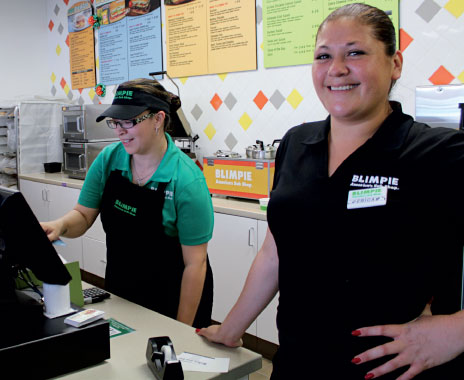At first glance, a nonprofit subdivision developer and a sandwich restaurant seem a far-fetched choice for partnership—ham and cheese and mortgages have seemingly little in common. But nonprofit executive Bobby Calvillo and Blimpie area developer Alan Crites found their visions for a community impact could intersect in a powerful way. The two teamed up to establish a Blimpie unit in southern Texas that channels funds to Calvillo’s affordable housing organization.
Calvillo, who has worked for 17 years as executive director of Affordable Homes of South Texas Inc. (AHSTI), says his organization provides affordable housing opportunities through home ownership to the area’s largely Hispanic community. “The Rio Grande Valley is long known for being one of the poorest in the country,” he says. “We have all the negative things here, like unemployment and poverty, that indicate a poor economy.”
One afternoon, while visiting one of his AHSTI offices, Calvillo watched nearby nursing students make a dash for lunch. He thought he could attract a lunch-type franchise to lease space owned by AHSTI in Welasco, Texas, and secure more funding.
That led him to connect with Crites, Blimpie’s area developer. But instead of simply opening a store, Crites suggested AHSTI act as the franchisee to fund its humanitarian efforts.
The idea of social entrepreneurship, where nonprofits operate a for-profit enterprise to produce funding, is not as uncommon as one might think, says Laura Otten, director of The Nonprofit Center at La Salle University’s School of Business. “The model has been around a long time,” she says, citing well-known Goodwill thrift shops. “What’s different is the recent trend toward franchise operations.”
Crites says he believed the Blimpie unit would succeed once the community understood the store’s intent to profit for a cause, and he expected there would be tremendous support.
For a nonprofit organization, this kind of venture raises unrestricted funds that can be used to pay for general operating expenses, Otten says. “When you ask a donor to give money for a specific activity or cause, that money is restricted and cannot be used to pay lights and mortgages,” she says. “It’s much easier to raise restricted funds because people like to give to specific causes, but we all know we can’t teach literacy and feed kids without infrastructure.”
Crites says it took more effort to launch the business with the AHSTI team, which needed to start with the basics of franchising, and the location was not an ideal one, though there were good catering opportunities.
“The feel-good aspect, the profits feeding back to the community for housing first-time owners or disadvantaged people, that gave them a leg up on everybody else,” he says. With the tagline “Great food for a great cause,” the Blimpie unit opened last summer. It’s already over the so-called “startup hump” and headed for profit by early spring.
Crites and Calvillo agree that staffing has been key to the unit’s success, and they made sure to hire a management team who brought core experience. That, along with the morale that comes with working for a cause, adds to the culture, making it “easier to stay late or make 1,200 box lunches,” Calvillo says.
The store also hires some of AHSTI’s clients, many of whom have few job skills. “It’s a great first step for some who have no education or haven’t worked outside the home,” Crites says.
There haven’t been too many obstacles since the operation launched, Crites says, though he and Calvillo faced trouble initially structuring a profit venture with AHSTI’s nonprofit status.
To combat complications, Calvillo formed a limited liability company (LLC), Esperanza on Fifth, to run the Blimpie unit. The LLC channels its funds to AHSTI. “Esperanza” means hope, Calvillo says.
“Hire someone as a consultant, for sure,” Calvillo says in regard to advice for other nonprofits that may seek similar opportunities. “We found out our projections were totally wrong. [Crites] and Blimpie have been invaluable in terms of support and helping us understand this business.”
“I’m really passionate about this one,” Crites says. “I’m very optimistic Bobby is going to have a good year, and if he wins, we all win.”
To Calvillo, the money is important, but he says it isn’t everything. “Rewards are more significant than potential earnings, and I go home every day knowing I might have made an impact on somebody, if not that day, then in the future,” he says.
Other franchisees who might consider a similar project should look less at a nonprofit’s size and more at its financial history and the stability of its paid leadership, Otten says.
“To a great extent, look for an organization that has shown innovation in the way it delivers its services. To take on a venture that isn’t mission-related is risky, so the nonprofit really has to understand they might have to wait for returns,” Otten says. “If they understand that model, they have the right mentality and thinking [for this kind of partnership].”
Crites says the right attitude is key for a quick-service brand establishing a nonprofit partnership.
“It’s a good thing for businesses to do. Yes, we all need to make money. But if you can couple that with a way to give back, then everybody is a winner,” he says. “It doesn’t have to be homes. It could be anything. It’s businesses helping charities without just writing a check. I hope it grows. I hope Blimpie leads the way.”












